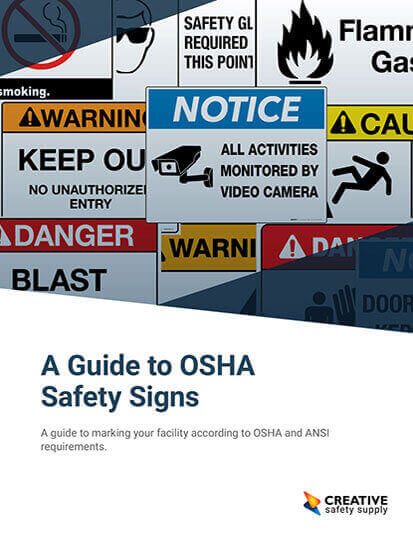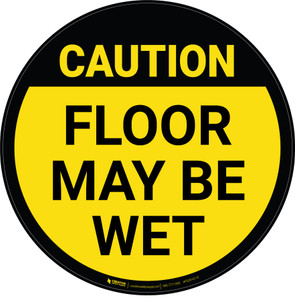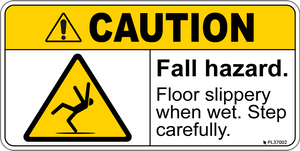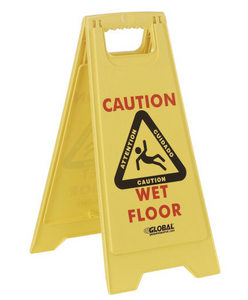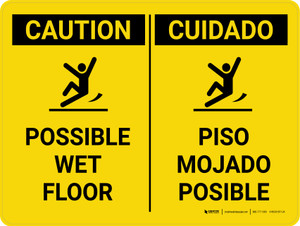
Floor & Wall Signs
Highly visible signs for wet areas.
Place wet floor warnings right where they’re needed with industrial-grade floor and wall signs. They'll hold up to water and chemicals, and floor signs can withstand foot and vehicle traffic.

Labels
Adhesive stickers to provide warnings.
Make sure areas prone to being wet are clearly labeled. These durable labels withstand water, chemicals, fading, and abrasions, so they work great in industrial facilities.

A-Frame Signs
For use in temporarily wet areas.
Use plastic A-frame signs to call attention to areas that are wet from cleaning, rain, or other short-term causes. Available in English or English/Spanish versions. Suitable for indoor and outdoor use.

4-Sided Square Signs
Cones to put out when needed.
Put plastic cone signs out to warn people about temporarily wet floors. These wet floor signs are easy to put in place and are visible from multiple directions and from a distance.
Why Do You Need Wet Floor Signs?
Wet floor warning and hazard signs are important for several reasons. The first and most critical reason is safety. Slips, trips, and falls are a real problem in the workplace. Falls on the same level are the second leading cause of workplace injuries, accounting for 15.4% of injuries, according the Bureau of Labor Statistics. They were also the second most costly injury in 2014 (after overexertion caused by outside sources). Wet floors are the culprits in many slip and fall accidents, so steps must be taken to prevent them.
Slip and fall incidents often result in injuries such as sprains, muscle tears, bruises, back and neck injuries, concussions, and broken bones in the arms that occur when someone instinctively tries to catch him or herself. These injuries can lead to time away from work and medical bills, and companies may need to find replacements for injured employees while they recover.
Slip and fall hazards on wet floors may seem trivial because we're used to seeing "Caution–Wet Floor" signs, but just because we're used to something doesn't mean the danger is actually any less. These accidents are common and can have serious consequences.
It's also important that businesses post wet floor signs because if they don't, they could face litigation if someone is injured. At a grocery store, for example, if a customer slips and falls because of an unmarked wet floor, he or she could claim the business was responsible and seek damage payments.
Many industrial workplaces are used to marking hazards of all kinds: chemicals hazards, machine hazards, electrical hazards, etc. So adding wet floor signs isn't too far outside the norm. It's still important to include them, though, and not assume they're too basic to be necessary. Make them a part of the workplace's visual communication system just like exit signs, no smoking signs, first aid signs, and no entry signs.
Wet Floor Sign Regulations
OSHA's standard for Walking-Working Surfaces, 29 CFR 1910.22, does not specifically mention floor signs, but it does state the importance of maintaining surfaces in clear, sanitary, and dry conditions. It also states, "Where wet processes are used, drainage shall be maintained, and false floors, platforms, mats, or other dry standing places should be provided where practicable."
Businesses should follow these instructions in addition to posting wet floor signs, which can increase safety and decrease liability. While there is no explicit wet floor sign law, you could still face legal difficulties if you fail to properly warn people about slip and falls hazards.
Types of Wet Floor Signage
As you can see above, wet floor signs come in a variety of styles and sizes. Simple caution labels or wall signs can get the job done. Some wet floor labels are printable, so with an industrial label printer you can make them yourself. Floor signs notify people of a hazard right where they need it. You can also use A-frame or cone signs that demand attention with their size. It's possible to get wood wet floor signs and plastic wet floor signs of this stand-up style. Choose the style that will best alert people to the wet floor hazard before they enter the area.
Locations Prone to Wet Floors
The industry, the type of work performed, and the type of surface itself can all play a role in whether wet floors are a problem in the workplace. The food and beverage industries, for example, deal with wet floors regularly. Wet floors are also a common problem in restrooms/showers, entryways, locker rooms, etc.
Some surfaces naturally provide more traction than others. Tile, marble, terrazzo, and linoleum floors can become especially slippery when wet. Pay extra attention in these areas and make sure proper signage is posted.
Wet Floor Prevention Methods
In addition to posting appropriate wet floor signs, you can also take steps to prevent wet floors from becoming a problem at your business in the first place. Consider these suggestions:
- Have procedures to clean up spills quickly. Spill kits can help.
- Have clear housekeeping procedures for floors to minimize the time floors are wet.
- Install good ventilation systems so floors dry quickly.
- Select floor surfaces with some texture/roughness for areas that will often be wet.
- Add traction tape to floors in wet areas.
- Place absorbent mats in entryways where people track in water when it rains/snows. Make sure the mats stay flat on the floor, though, so their edges/corners don't create new tripping hazards.
- Install drainage in restrooms and wet areas so puddles don't become a problem.
- Encourage people to wear footwear with appropriate traction.
Additional Safety Floor Signs
Slippery floor signs play an important role in workplace safety, and combined with other safety signs, they provide your employees and visitors with an easy-to-understand communication system.
An important takeaway: just because a sign seems basic doesn't make it's not important. Basic signs such as parking signs, door signs, restroom signs, and exit signs give people simple instructions that make spaces easier to navigate. Wet floor signs also serve a similar purpose; they help people move safely through your space.
-

Slippery When Wet Floor Sign Our floor signs inform workers of a potential slipping hazard. These floor signs are tough and can withstand extreme conditions. Customize these caution signs at no additional charge. If you would like different text or to... More details
Slippery When Wet Floor Sign
$17.00 -

Slippery When Wet B (Floor Sign) Use this sign to alert workers to slip and fall hazards. Features Durable plastic construction For indoor or outdoor use Easy to install - just peel and stick! Bright yellow for maximum visibility Customize at no... More details
-

Caution Slippery When Wet Inform employees and visitors about slippery surfaces with our Caution Slippery When Wet sign. This sign features an easy-to-understand pictogram as well as simple-to-read, high-impact text. Make sure your work environment is... More details
Caution Slippery When Wet
$17.99 -

Wet Floor Caution Sign English / Spanish Prevent a slip and fall accident with this multilingual A-frame sign. It folds quickly and easily for rapid deployment, transportability, and easy storage. Features Made out of plastic for its light weight... More details
Wet Floor Caution Sign English / Spanish
MSRP: $24.99Was: $24.99Sale: $19.99(Save $5.00) -

Indicate where wet flooring may cause slipping hazards. Can increase safety near temporary spills or leaks before repair/mopping can occur. 3 size options available Easy peel-and-stick application Strong adhesive for high durability Chemical,... More details
-

Ideal for areas with frequent standing water such as locker rooms and pools. Increases safety awareness. 3 size options available Easy peel-and-stick application Strong adhesive for high durability Chemical, water, and smear resistant Removable... More details
-

This Caution: Floor May Be Wet - Floor Sign features a high contrast and bold design that can be easily seen from a distance, and is constructed using tough, industrial-grade materials, allowing it to survive in the most severe work environment. Our... More details
-

This Caution Possible Wet Floor Bilingual Spanish Portrait - Wall Sign is constructed using durable, industrial-grade materials, and is designed to be easily noticeable from a distance. Our wall signs such as this one, can be mounted anywhere necessary,... More details
-

This Caution: Floor May Be Slippery When Wet with Icon ANSI Portrait - Wall Sign is constructed using durable, industrial-grade materials, and is designed to be easily noticeable from a distance. Our wall signs such as this one, can be mounted anywhere... More details
-

This Caution: Floor May Be Slippery When Wet with Icon Portrait - Wall Sign is constructed using durable, industrial-grade materials, and is designed to be easily noticeable from a distance. Our wall signs such as this one, can be mounted anywhere... More details
-

Caution: Wet Floor - Wall Sign Efficiently warn personnel of wet floors with noticeable “Caution: Wet Floor” wall sign. This durable wall sign can be mounted permanently for constantly wet floors, or mounted temporarily for accidental... More details
-

Rubbermaid Caution Wet Floor Sign – 2 Sided This Caution wet floor sign effectively warns employees and passerby of slipping hazards by using a brightly colored construction and bold and easy to read graphics. The Caution Wet Floor sign is... More details
-

This Caution: Floor Slippery When Wet with Icon Landscape - Wall Sign is constructed using durable, industrial-grade materials, and is designed to be easily noticeable from a distance. Our wall signs such as this one, can be mounted anywhere necessary,... More details
-

This Caution: Floor May Be Slippery When Wet with Icon Landscape - Wall Sign is constructed using durable, industrial-grade materials, and is designed to be easily noticeable from a distance. Our wall signs such as this one, can be mounted anywhere... More details
-

ANSI Label - Caution! - Fall Hazard - Slippery When Wet This label can be applied to many surfaces. The availability of sizes makes it a very versatile option (2" x 4" - 5.5" x 11"). Available in 4 sizes Sold... More details
-

This Caution: Ramp May Be Slippery When Wet or Icy Landscape - Wall Sign is constructed using durable, industrial-grade materials, and is designed to be easily noticeable from a distance. Our wall signs such as this one, can be mounted anywhere... More details
-

This Caution: Slippery When Wet - Wall Sign is constructed using durable, industrial-grade materials, and is designed to be easily noticeable from a distance. Our wall signs such as this one, can be mounted anywhere necessary, such as doors, sign posts,... More details
-

Global Industrial Wet Floor Sign – 2 Sided Multi-Lingual Prevent dangerous fall injuries due to wet floors with a clear multi-lingual 2 Sided Wet Floor Sign from Global Industrial. This wet floor sign features a trilingual warning that reads... More details
-

This Caution: Possible Wet Floor Bilingual Spanish Landscape With Icons - Wall Sign is constructed using durable, industrial-grade materials, and is designed to be easily noticeable from a distance. Our wall signs such as this one, can be mounted... More details
-

Global Industrial Wet Floor Sign – 2 Sided Protect employees and prevent injuries from slippery surfaces with this 2 Sided “Caution Wet Floor” A-Frame Sign. By offering clear identification of the slipping hazard, you can easily warn... More details

